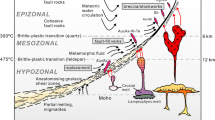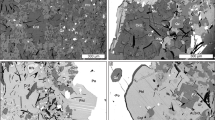Abstract
The newly discovered Cretaceous Coffee orogenic gold deposit (>4 Moz resource) consists of an extensive oxidised zone developed on primary sulphidic rock. The primary mineralised rock is characterised by invisible gold in arsenian pyrite that has replaced biotite in selected host rocks. The deposit has a cryptic surface expression and is an example of an extremely subtle exploration target. Hydrothermal emplacement was controlled by extensional fractures, with breccias, but most mineralisation was focused on biotite-bearing granitic gneiss, metasedimentary gneisses, and younger biotite granite. Fine-grained (<0.1 mm) arsenian pyrite replaced biotite along mineral cleavage planes and followed biotite-rich metamorphic and post-metamorphic structural fabrics. Arsenian pyrite also formed overgrowths on earlier coarse-grained (up to 2 mm) barren hydrothermal pyrite. Arsenian pyrite is concentrically zoned on the 1–10-μm scale with respect to As, Sb, and Au contents and typically contains ∼5 wt% As, ∼500 mg/kg Sb, and ∼500 mg/kg Au, in solid solution. Biotite replacement was accompanied by sericitisation, silicification, and ankerite impregnation. Hydrothermal alteration involved dilution and localised depletion of K, Na, and Al in silicified host rocks, but most Ca, Mg, and Fe concentrations remained broadly constant. Magnesium-rich ultramafic host rocks were only weakly mineralised with auriferous arsenian pyrite and have fuchsite and magnesite alteration. Near-surface oxidation has liberated nanoparticulate and microparticulate supergene gold, which remains essentially invisible. Varying degrees of oxidation extend as deep as 250 m below the present subdued topographic surface, well beyond the present vadose zone, and this deep oxidation may have occurred during post-mineralisation uplift and erosion in the Cretaceous. Oxidation has leached some As from the surficial mineralised rocks, decreasing the geochemical signal, which is also obscured by the localised presence of high background As (up to 100 mg/kg) in metasedimentary quartzites in the region. Antimony provides more reliable soil anomalies than As, but most Sb anomalies are <100 mg/kg. The persistence of invisible gold into the extensive supergene zone, with little gold particle size enhancement, has ensured that no placer deposits have formed in nearby streams, further restricting the surface footprint and Au dispersal halo of this subtle exploration target.













Similar content being viewed by others
References
Allan MM, Mortensen JK, Hart CJR, Bailey LA, Sanchez MG, Ciolkiewicz W, McKenzie GG, Creaser RR (2013) Magmatic and metallogenic framework of west-central Yukon and eastern Alaska. SEG Spec Publ 17:111–168
Bailey LA (2013) Late Jurassic fault-hosted gold mineralization of the Golden Saddle deposit, White Gold district, Yukon Territory. MSc thesis, University of British Columbia, Canada, 170 p
Bierlein FP, Crowe D (2000) Phanerozoic orogenic lode gold deposits. In: Gold in 2000. Hagemann SG, Brown PE (eds) Rev Econ Geol 13:103–140
Bowell RJ (1992) Supergene gold mineralogy at Ashanti, Ghana: implications for the supergene behaviour of gold. Min Mag 56:545–560
Boyle RW (1979) The geochemistry of gold and its deposits. Geol Surv Canada Bull 280: 579 pp
Buitenhuis E (2014) The Latte gold zone, Kaminak’s Coffee gold project, Yukon, Canada: geology, geochemistry, and metallogeny. MSc thesis, University of Western Ontario, Canada, 195 p
Chapman RJ, Mortensen JK, LeBarge WP (2011) Styles of lode gold mineralization contributing to the placers of the Indian River and Black Hills Creek, Yukon Territory, Canada as deduced from microchemical characterization of placer gold grains. Mineral Deposita 46:881–903
Cook NJ, Ciobanu CL, Mao J (2009) Textural control on gold distribution in As-free pyrite from the Dongping, Huangtuliang and Hougou gold deposits, North China craton (Hebei Province, China). Chem Geol 264:101–121
Craw D (2010) Delayed accumulation of placers during exhumation of orogenic gold in southern New Zealand. Ore Geol Rev 37:224–235
Deditius AP, Utsunomiya S, Reich M, Kesler SE, Ewing RC, Hough R, Walshe J (2011) Trace metal nanoparticles in pyrite. Ore Geol Rev 42:32–46
Eilu P, Groves DI (2001) Primary alteration and geochemical dispersion haloes of Archaean orogenic gold deposits in the Yilgarn Craton; the pre-weathering scenario. Geochem Explor Environ Anal 1:183–200
Gao ZL, Kwak TAP, Changkakoti A, Hussein E, Gray J (1995) Supergene ore and hypogene nonore mineralization of the Nagambie sediment-hosted gold deposit, Victoria, Australia. Econ Geol 90:1747–1763
Godwin CI (1975) Alternative interpretations for the Casino Comples and Klotassin Batholith in the Yukon Crystalline Terrane. Can J Earth Sci 12:1910–1916
Goldfarb RJ, Groves DI, Gardoll S (2001) Orogenic gold and geologic time: a global synthesis. Ore Geol Rev 18:1–75
Goldfarb RJ, Baker T, Dube B, Groves DI, Hart CJ, Gosselin P (2005) Distribution, character and genesis of gold deposits in metamorphic terranes. In: Hedenquist JW, Thompson JFH, Goldfarb RJ, Richards JP (eds) Econ Geol 100th Anniv Volume, 407–450
Hong HL, Wang QY, Chang JP, Liu SR, Hu R (1999) Occurrence and distribution of invisible gold in the Shewushan supergene gold deposit China. Can Mineral 38:1525–1531
Knight JB, Mortensen JK, Morison SR (1999) Lode and placer gold composition in the Klondike district, Yukon Territory, Canada: implications for the nature and genesis of Klondike placer and lode gold deposits. Econ Geol 94:649–664
Large RR, Maslennikov V, Robert F, Danyushevsky LV, Chang Z (2007) Multistage sedimentary and metamorphic origin of pyrite and gold in the giant Sukhoi Log deposit, Lena gold province, Russia. Econ Geol 102:1232–1267
Large RR, Danyushevsky L, Hollit C, Maslennikov V, Meffre S, Gilbert S, Bull S, Scott R, Emsbo P, Thomas H, Singh B, Foster J (2009) Gold and trace element zonation in pyrite using a laser imaging technique: implications for the timing of gold in orogenic and Carlin-style sediment-hosted deposits. Econ Geol 104:635–668
Large R, Thomas H, Craw D, Henne A, Henderson S (2012) Diagenetic pyrite as a source for metals in orogenic gold deposits, Otago Schist, New Zealand. NZ J Geol Geophys 55:137–149
Lawrance LM, Griffin BJ (1994) Crystal features of gold at Hannan South, Western Australia. Mineral Deposita 29:391–398
Lowey GW (2006) The origin and evolution of the Klondike goldfields, Yukon, Canada. Ore Geol Rev 28:431–450
MacKenzie D, Craw D, Mortensen JK (2008a) Structural controls on orogenic gold mineralisation in the Klondike goldfield, Canada. Mineral Deposita 43:435–448
MacKenzie D, Craw D, Mortensen JK, Liverton T (2008b) Disseminated gold mineralization associated with orogenic veins in the Klondike Schist, Yukon. In: YEG 2007, Yukon Geol Survey, p 215–224
MacKenzie D, Craw D, Cooley M, Fleming A (2010) Lithogeochemical localisation of disseminated gold in the White River area, Yukon, Canada. Mineral Deposita 45:683–705
MacKenzie D, Craw D, Brodie C., Fleming A (2013) Foliation development and hydrothermal gold emplacement in metagabbroic rocks, central Yukon, Canada. In: YEG 2012, Yukon Geol Survey, p 47–64
MacKenzie D, Craw D, Finnigan C (2014) Structural controls on alteration and mineralization at the Coffee gold deposits, Yukon. In: YEG 2013, Yukon Geol Survey, p 119–130
Mann AW (1984) Mobility of gold and silver in lateritic weathering profiles: some observations from Western Australia. Econ Geol 79:38–49
McClenaghan MB, Cabri LJ (2011) Review of gold and platinum group element (PGE) indicator minerals methods for surficial sediment sampling. Geochem Explor Environ Anal 11:251–263
McCuaig TC, Kerrich R (1998) P-T-t-deformation-fluid characteristics of lode gold deposits: evidence from alteration systematics. Ore Geol Rev 12:381–453
McKenzie GG, Allan MM, Mortensen JK, Hart CJR, Sánchez M, Creaser RA (2013) Mid-Cretaceous orogenic gold and molybdenite mineralization in the Independence Creek area, Dawson Range, parts of NTS 115J/13 and 14. In: YEG 2012, Yukon Geol Survey, p 73–97
Mikhlin Y, Romanchenko A, Likhatski M, Karacharov A, Erenburg S, Trubina S (2011) Understanding the initial stages of precious metals precipitation: nanoscale metallic and sulfidic species of gold and silver on pyrite surfaces. Ore Geol Rev 42:47–54
Mikucki EJ (1998) Hydrothermal transport and depositional processes in Archean lode-gold systems: a review. Ore Geol Rev 13:307–321
Monger JWH, Nokelberg WJ (1996) Evolution of the northern North American Cordillera: generation, fragmentation, displacement and accretion of successive North American plate–margin arc. In: Coyner AR, Fahey PL (eds) Geology and ore deposits of the American Cordillera. Geol Soc Nev, Reno, Nev, 3:1133–1152
Mortensen JK (1992) Pre–mid–Mesozoic evolution of the Yukon–Tanana terrane, Yukon and Alaska. Tectonics 11:836–853
Mumin AH, Fleet ME, Chryssoulis SL (1994) Gold mineralisation in As-rich mesothermal gold ores of the Bogosu-Prestea mining district of the Ashanti gold belt, Ghana: remobilization of “invisible” gold. Mineral Deposita 29:445–460
Palenik CS, Utsunomiya S, Reich M, Kesler SE, Wang L, Ewing RC (2004) “Invisible” gold revealed: direct imaging of gold nanoparticles in a Carlin-type deposit. Am Mineral 89:1359–1366
Petrie BS, Craw D, Ryan CG (2005) Geological controls on refractory ore in an orogenic gold deposit, Macraes mine, New Zealand. Mineral Deposita 40:45–58
Ramsay WRH, Bierlein FP, Arne DC, VandenBerg AHM (1998) A review of turbidite-hosted gold deposits, central Victoria: regional setting, styles of mineralisation and genetic constraints. Ore Geol Rev 13:131–151
Reich M, Kesler SE, Utsunomiya S, Palenik CS, Chryssoulis SL, Ewing RC (2005) Solubility of gold in arsenian pyrite. Geochim Cosmochim Acta 69:2781–2796
Simard M, Gaboury D, Daigneault R, Mercier-Langevin P (2013) Multistage gold mineralization at the Lapa mine, Abitibi Subprovince: insights into auriferous hydrothermal and metasomatic processes in the Cadillac–Larder Lake Fault Zone. Mineral Deposita 48:883–905
Simon G, Kesler SE, Chryssoulis S (1999) Geochemistry and textures of gold-bearing arsenian pyrite, Twin Creeks, Nevada: implications for deposition of gold in Carlin-type deposits. Econ Geol 94:405–421
Stoffregen R (1986) Observations on the behavior of gold during supergene oxidation at Summitville, Colorado, USA, and implications for electrum stability in the weathering environment. Appl Geochem 1:549–558
Sung Y-H, Brugger J, Ciobanu CL, Pring A, Skinner W, Nugus M (2009) Invisible gold in arsenian pyrite and arsenopyrite from a multistage Archaean gold deposit: Sunrise Dam, Eastern Goldfields province, Western Australia. Mineral Deposita 44:765–791
Thomas HV, Large RR, Bull SW, Maslennikov V, Berry RF, Fraser R, Froud S, Moye R (2011) Pyrite and pyrrhotite textures in sediments, laminated quartz veins, and reefs at Bendigo gold mine, Australia: insights for ore genesis. Econ Geol 106:1–31
Thompson JFH, Sillitoe RH, Baker T, Land JR, Mortensen JK (1999) Intrusion-related gold deposits associated with tungsten-tin provinces. Mineral Deposita 34:323–334
Townley BK, Herail G, Maksaev V, Palacios C, de Parseval P, Sepuldeva F, Orellana R, Rivas P, Ulloa C (2003) Gold grain morphology and composition as an exploration tool: application to gold exploration in covered areas. Geochem Explor Environ Anal 3:29–38
Vaughan JP, Kyin A (2004) Refractory gold ores in Archaean greenstones, Western Australia: mineralogy, gold paragenesis, metallurgical characterization and classification. Min Mag 68:255–277
Velasquez G, Beziat D, Salvi S, Siebenaller L, Borisova AY, Pokrovski GS, de Parseval P (2014) Formation and deformation of pyrite and implications for gold mineralization in the El Callao District, Venezuela. Econ Geol 109:457–486
Wainwright AJ, Simmons AT, Finnigan CS, Smith TR, Carpenter RL (2011) Geology of new gold discoveries in the Coffee Creek area, White Gold district, west-central Yukon. YEG 2010, Yukon Geol Surv, p 233–247
Acknowledgments
This research was funded by Kaminak Gold Corporation, University of Otago, NZ Ministry for Business Innovation and Employment, and the Marsden Fund administered by the Royal Society of New Zealand. Logistical assistance and numerous fruitful discussions by Kaminak staff, especially Eira Thomas, Tim Smith, Adam Fage, and Geoff Newton, are much appreciated and contributed substantially to the research outcomes. Constructive reviews by two anonymous referees, combined with careful editing by Georges Beaudoin, helped to clarify and improve the presentation.
Author information
Authors and Affiliations
Corresponding author
Additional information
Editorial handling: T. Bissig and G. Beaudoin
Craig Finnigan passed away during the preparation of this study (2014).
Rights and permissions
About this article
Cite this article
MacKenzie, D., Craw, D. & Finnigan, C. Lithologically controlled invisible gold, Yukon, Canada. Miner Deposita 50, 141–157 (2015). https://doi.org/10.1007/s00126-014-0532-5
Received:
Accepted:
Published:
Issue Date:
DOI: https://doi.org/10.1007/s00126-014-0532-5




